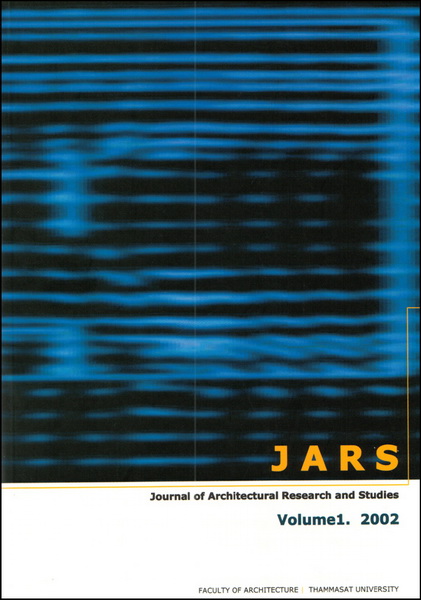Typology and Life Style Analysis of the Raft House (Ruan Pae) in Riverine Settlements in Thailand
Main Article Content
Abstract
This paper describes two areas concerning raft houses in Thailand for the purpose of (1) the classification of the raft house typology, measured by field surveys and mapping, and (2) the study of the way of life of the inhabitants and their satisfaction towards living in the raft houses, as well as the conditions of the raft house settlements, as researched by questionnaires and in-depth interviews. This study encompasses three subareas of study including (1) the physical features of the raft houses, (2) the way of living in them, and (3) the coexistence of the inhabitants, water and land. It is found that: (1) the typological features are varied by location, function and life style, (2) the conditions of the inhabitants in the raft houses are insecure for today’s living, (3) the existence of the raft house communities depends on the coexistence of the environments of water and mankind.
Downloads
Article Details

This work is licensed under a Creative Commons Attribution-NonCommercial-NoDerivatives 4.0 International License.
All material is licensed under the terms of the Creative Commons Attribution 4.0 International (CC-BY-NC-ND 4.0) License, unless otherwise stated. As such, authors are free to share, copy, and redistribute the material in any medium or format. The authors must give appropriate credit, provide a link to the license, and indicate if changes were made. The authors may do so in any reasonable manner, but not in any way that suggests the licensor endorses you or your use. The authors may not use the material for commercial purposes. If the authors remix, transform, or build upon the material, they may not distribute the modified material, unless permission is obtained from JARS. Final, accepted versions of the paper may be posted on third party repositories, provided appropriate acknowledgement to the original source is clearly noted.
References
Ornsiri Panin. (1995). Typical houses and villages. Bangkok: Silpakorn University.
The raft houses survive only in 8 provinces: Kampaengpetch, Phitsanulok, Uthaithani, Ayuthaya, Chachoengsao, Samutsakorn, Nakornpathom and Kanchanaburi. Recently, the authors rechecked and found that raft houses in Kampaengpetch, Samutsakorn and Nakornpathom had disappeared. However, they have been found in 2 other provinces, Nongbualampoo and Lampoon.
National Housing Authority. (1998). The relocation of raft house settlements in Phitsanulok. Bangkok.
The survey was conducted by students of Kinki University and the staff of the National Housing Authority during the year 1995 in Uthaithani, and was rechecked in the year 1997 in Phitsanulok and Uthaithani.
Faculty of Social Welfare. (1973). Research report on raft houses in Uthaithani and Phitsanulok province.Bangkok: Thammasat University.
Srisuwan Saengsiri. (1978). Living condition of residents in raft houses on Nan river. Phitsanulok: Srinakarinwirot University.
Rukthai Singsatid. (1978). Raft houses in Pad-Rew, MA. diss., Silpakorn University.
Terdsak Tachakitkachorn. (1998). Waterfront dwellings in the lower part of the Chao Phraya delta: Case study of Klong Bangkuwaing, Nonthaburi. Japan: Kobe University.
Royal Institute. (1982). Thai dictionary. Bangkok.
Viboon Leesuwan. (1978). Thai heritage. Bangkok: Panya publication.
Ruethai Chaichongrak. (1996). Traditional Thai houses of the central plain area (2nd ed.). Bangkok.
Local Administration Office. (1998). Population and housing in 1998 monthly report. Bangkok.
We chose these provinces because the characteristics are different in settlement locations, house sizes, inhabitants‘ life style and so on. Additionally, Uthaithani province was the first to introduce trash can in every household.


